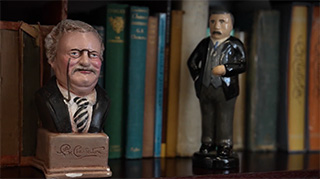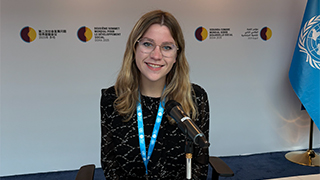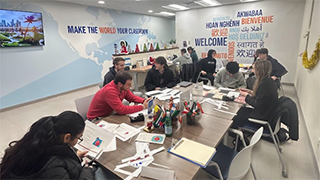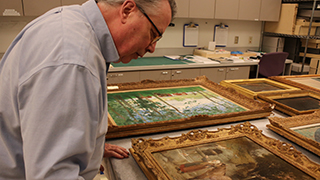A Deep Dive Into the Hospitality of God in the Gospel of Luke
Thursday, July 17, 2025
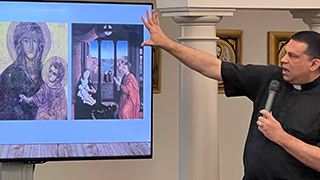
Father Ciriaco describing a painting of the Blessed Virgin Mary
On June 21, 2025, prayer, Scripture and art took center stage during a day of reflection at Immaculate Conception Seminary School of Theology (ICSST), Seton Hall University. “The Hospitality of God in the Gospel of Luke” was led by Father Dominic Ciriaco, D.Min., director of ICSST’s Preaching as Hospitality Formation Program, and Gregory Glazov, D.Phil. (Oxon.), professor and chair of the Department of Biblical Studies, as part of their "Scripture and Hospitality" summer course held from June 10-26, 2025.
Over forty participants gathered in the Seminary refectory to listen to and participate in presentations that nourished the mind and soul. Welcomed by Reverend Monsignor Gerard McCarren, S.T.D., Rector/Dean of ICSST, the group enjoyed camaraderie with refreshments and a meal. At midday, the participants attended Mass in the University Chapel on the feast day of St. Aloysius Gonzaga, whose hospitality in caring for the sick was highlighted in Father Ciriaco’s homily.
During the day’s sessions, Father Ciriaco explained Visio Divina, or praying with sacred art, as he featured paintings connected with the Gospel of Luke, including the Annunciation, the Visitation, the Last Supper, the Crucifixion and the Entombment. He began with Salvador Dali’s “Sacrament of the Last Supper” as an example of how Scripture and art portray hospitality. After being encouraged to spot each painting’s themes and hidden messages of hospitality, participants shared details such as the number of people shown, an angel’s mannerisms and how Mary and Elizabeth touched each other’s stomachs, rejoicing for the babies within their wombs. Participants also discussed Leonardo da Vinci’s “The Last Supper” and James Tissot’s “What Our Lord Saw from the Cross.” Many were especially moved by Tissot’s piece, which captures the profound emotions of Good Friday, particularly Jesus’ mother weeping at His feet. These themes were also noted in Rogier van der Weyden’s “Entombment of Christ,” depicting people caring for Jesus’ body and Joseph of Arimathea offering his tomb for Jesus.
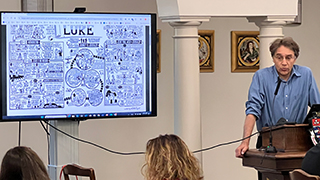
Glazov lecturing in front of the participants.
While Father Ciriaco examined the visuals of Luke’s Gospel, Glazov analyzed key Scripture passages related to Christian hospitality, including Luke 4:16-30, where Jesus delivers his first sermon in the synagogue of his hometown of Nazareth, and Luke 6:20-26, the Sermon on the Plain. A Scripture scholar, Glazov discussed Jesus’ mission of bringing hope and healing to those in need, including those experiencing several types of poverty — both physical and spiritual — and how we can reflect on it. “In our own lives, how do we treat people? What is it that motivates us to come to God to do good things?” Glazov emphasized.
With lively and inspiring detail, Glazov described several parables illustrating hospitality, such as the Parable of the Sower (Luke 8:4-15), which emphasizes that we are the soil and God’s Word is the seed; just as soil receives a seed, our hearts accept and nurture the Word. He also explained the Parables of the Lost Sheep (Luke 15:1-7), the Lost Coin (Luke 15:8-10), and the Prodigal Son (Luke 15:11-32), highlighting how God cares for us and searches tirelessly when we are lost. Like the father in the Parable of the Prodigal Son, God’s hospitality always welcomes us, even when we turn away. “He thinks, ‘In my father’s house, I will be accepted,’” Glazov said. “He knows that his father loves him; he knows he will be accepted.” Glazov also connected these parables to Luke’s emphasis on the lost and marginalized, highlighting Luke’s focus on figures such as the shepherds at Jesus’ birth and the Good Thief (St. Dismas) at Jesus' Crucifixion and death. “You can see how Luke frames things,” he noted. “It’s all about the lost.”
The day of reflection concluded with a reconsideration of Dali’s painting, followed by a closing prayer offered by Father Ciriaco. One participant remarked, “What a joy and blessing to have this opportunity to be together, learn, and pray.”
This event was sponsored by ICSST’s Preaching as Hospitality Formation Program, directed by Father Ciriaco. Our program seeks to form seminarians, diaconal students and religious and lay ICSST graduate students of theology to be compelling preachers who will offer a hospitality of the heart as they break open the Word of God. We intend to form preachers who understand and embrace preaching as hospitality—a ministry of inviting, welcoming, sharing and offering compassion. We will also encourage priests and deacons to join us on this journey and reimagine their preaching through the lens of Christian hospitality.
To learn more about ICSST’s Preaching as Hospitality Formation Program, please contact Alyssa Carolan at alyssa.carolan@shu.edu.
Categories: Faith and Service


